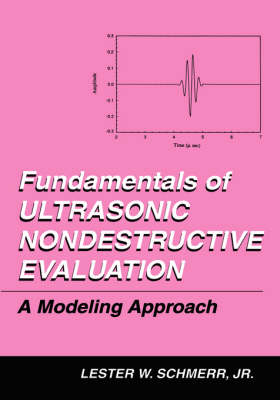
Fundamentals of Ultrasonic Nondestructive Evaluation
A Modeling Approach
Seiten
1998
|
1998 ed.
Plenum Publishing Co.,N.Y. (Verlag)
9780306457524 (ISBN)
Plenum Publishing Co.,N.Y. (Verlag)
9780306457524 (ISBN)
- Titel erscheint in neuer Auflage
- Artikel merken
Zu diesem Artikel existiert eine Nachauflage
Ultrasound is currently used in a wide spectrum of applications ranging from medical imaging to metal cutting. This book is about using ultrasound in nondestructive evaluation (NDE) inspections. Ultrasonic NDE uses high-frequency acoustic/elastic waves to evaluate components without affecting their integrity or performance. This technique is commonly used in industry (particularly in aerospace and nuclear power) to inspect safety-critical parts for flaws during in-service use. Other important uses of ultrasonic NDE involve process control functions during manufacturing and fundamental materials characterization studies. It is not difficult to set up an ultrasonic NDE measurement system to launch waves into a component and monitor the waves received from defects, such as cracks, even when those defects are deep within the component. It is difficult however to interpret quantitatively the signals received in such an ultrasonic NDE measurement process. For example based on the ultrasonic signal received from a crack, what is the size, shape, and orientation of the crack producing the signal?
Answering such questions requires evaluation procedures based on a detailed knowledge of the physics of the entire ultrasonic measurement process. One approach to obtaining such knowledge is to couple quantitative experiments closely with detailed models of the entire ultrasonic measurement system itself. We refer to such models here as ultrasonic NDE measurement models. In other areas of engineering, models have revolutionized how engineering is practiced. A classic example is the impact of the finite-element method on elastic stress analysis.
Answering such questions requires evaluation procedures based on a detailed knowledge of the physics of the entire ultrasonic measurement process. One approach to obtaining such knowledge is to couple quantitative experiments closely with detailed models of the entire ultrasonic measurement system itself. We refer to such models here as ultrasonic NDE measurement models. In other areas of engineering, models have revolutionized how engineering is practiced. A classic example is the impact of the finite-element method on elastic stress analysis.
1. An Ultrasonic System. 2. Linear Systems and the Fourier Transform. 3. Fundamentals. 4. Propagation of Bulk Waves. 5. Reciprocal Theorem and Other Integral Relations. 6. Reflection and Refraction of Bulk Waves. 7. Propagation of Surface and Plate Waves. 8. Ultrasonic Transducer Radiation. 9. Materials Attenuation and Efficiency Factors. 10. Flaw Scattering. 11. Transducer Reception Process. 12. Ultrasonic Measurement Models. 13. Near-Field Measurement Models. 14. Quantitative Ultrasonic NDE with Models. 15. Model-Based Flaw Sizing. Appendixes: A. Fourier Transform. B. Dirac Delta Function. C. Basic Notations and Concepts. D. Hilbert Transform. E. Stationary Phase Method. F. Properties of Ellipsoids. Index.
| Zusatzinfo | biography |
|---|---|
| Verlagsort | New York |
| Sprache | englisch |
| Maße | 178 x 254 mm |
| Gewicht | 2880 g |
| Themenwelt | Naturwissenschaften ► Physik / Astronomie ► Astronomie / Astrophysik |
| Technik ► Maschinenbau | |
| ISBN-13 | 9780306457524 / 9780306457524 |
| Zustand | Neuware |
| Informationen gemäß Produktsicherheitsverordnung (GPSR) | |
| Haben Sie eine Frage zum Produkt? |
Mehr entdecken
aus dem Bereich
aus dem Bereich
Grundlagen, Anwendungen in Astrophysik und Kosmologie sowie …
Buch | Softcover (2022)
Springer Spektrum (Verlag)
CHF 69,95
Kompendium & Nachschlagewerk in 3 Bänden
Buch | Hardcover (2025)
Eigenverlag Dr. Erik Wischnewski
CHF 179,95



